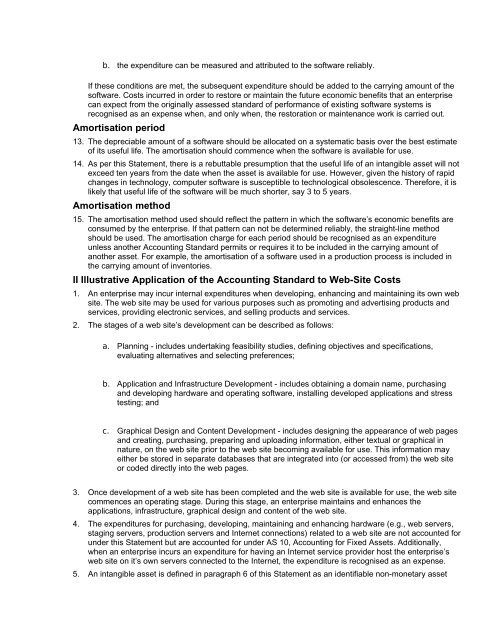Accounting Standards 1-29 - Seth & Associates
Accounting Standards 1-29 - Seth & Associates
Accounting Standards 1-29 - Seth & Associates
Create successful ePaper yourself
Turn your PDF publications into a flip-book with our unique Google optimized e-Paper software.
. the expenditure can be measured and attributed to the software reliably.<br />
If these conditions are met, the subsequent expenditure should be added to the carrying amount of the<br />
software. Costs incurred in order to restore or maintain the future economic benefits that an enterprise<br />
can expect from the originally assessed standard of performance of existing software systems is<br />
recognised as an expense when, and only when, the restoration or maintenance work is carried out.<br />
Amortisation period<br />
13. The depreciable amount of a software should be allocated on a systematic basis over the best estimate<br />
of its useful life. The amortisation should commence when the software is available for use.<br />
14. As per this Statement, there is a rebuttable presumption that the useful life of an intangible asset will not<br />
exceed ten years from the date when the asset is available for use. However, given the history of rapid<br />
changes in technology, computer software is susceptible to technological obsolescence. Therefore, it is<br />
likely that useful life of the software will be much shorter, say 3 to 5 years.<br />
Amortisation method<br />
15. The amortisation method used should reflect the pattern in which the software’s economic benefits are<br />
consumed by the enterprise. If that pattern can not be determined reliably, the straight-line method<br />
should be used. The amortisation charge for each period should be recognised as an expenditure<br />
unless another <strong>Accounting</strong> Standard permits or requires it to be included in the carrying amount of<br />
another asset. For example, the amortisation of a software used in a production process is included in<br />
the carrying amount of inventories.<br />
II Illustrative Application of the <strong>Accounting</strong> Standard to Web-Site Costs<br />
1. An enterprise may incur internal expenditures when developing, enhancing and maintaining its own web<br />
site. The web site may be used for various purposes such as promoting and advertising products and<br />
services, providing electronic services, and selling products and services.<br />
2. The stages of a web site’s development can be described as follows:<br />
a. Planning - includes undertaking feasibility studies, defining objectives and specifications,<br />
evaluating alternatives and selecting preferences;<br />
b. Application and Infrastructure Development - includes obtaining a domain name, purchasing<br />
and developing hardware and operating software, installing developed applications and stress<br />
testing; and<br />
c. Graphical Design and Content Development - includes designing the appearance of web pages<br />
and creating, purchasing, preparing and uploading information, either textual or graphical in<br />
nature, on the web site prior to the web site becoming available for use. This information may<br />
either be stored in separate databases that are integrated into (or accessed from) the web site<br />
or coded directly into the web pages.<br />
3. Once development of a web site has been completed and the web site is available for use, the web site<br />
commences an operating stage. During this stage, an enterprise maintains and enhances the<br />
applications, infrastructure, graphical design and content of the web site.<br />
4. The expenditures for purchasing, developing, maintaining and enhancing hardware (e.g., web servers,<br />
staging servers, production servers and Internet connections) related to a web site are not accounted for<br />
under this Statement but are accounted for under AS 10, <strong>Accounting</strong> for Fixed Assets. Additionally,<br />
when an enterprise incurs an expenditure for having an Internet service provider host the enterprise’s<br />
web site on it’s own servers connected to the Internet, the expenditure is recognised as an expense.<br />
5. An intangible asset is defined in paragraph 6 of this Statement as an identifiable non-monetary asset




